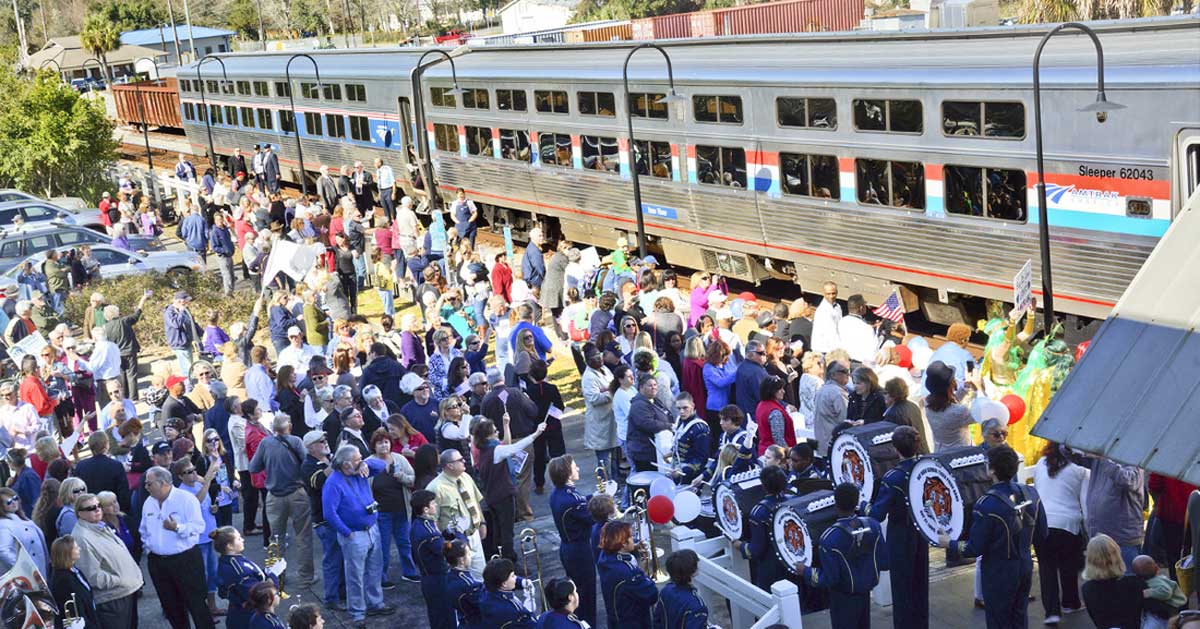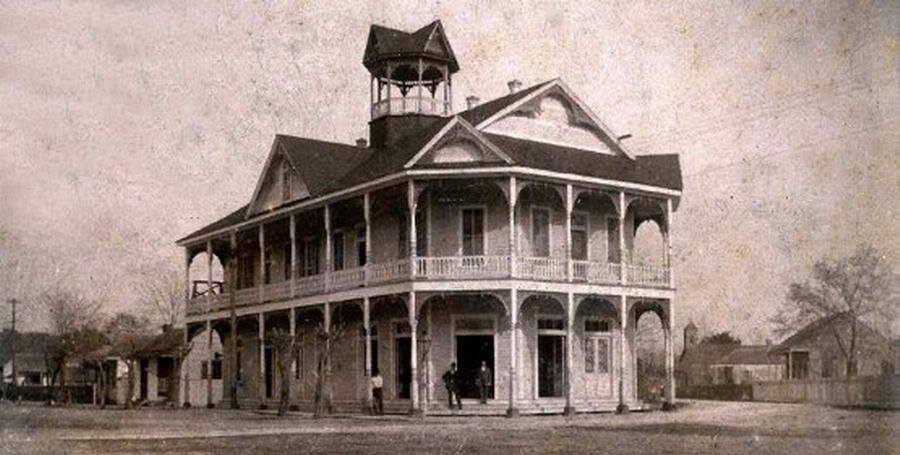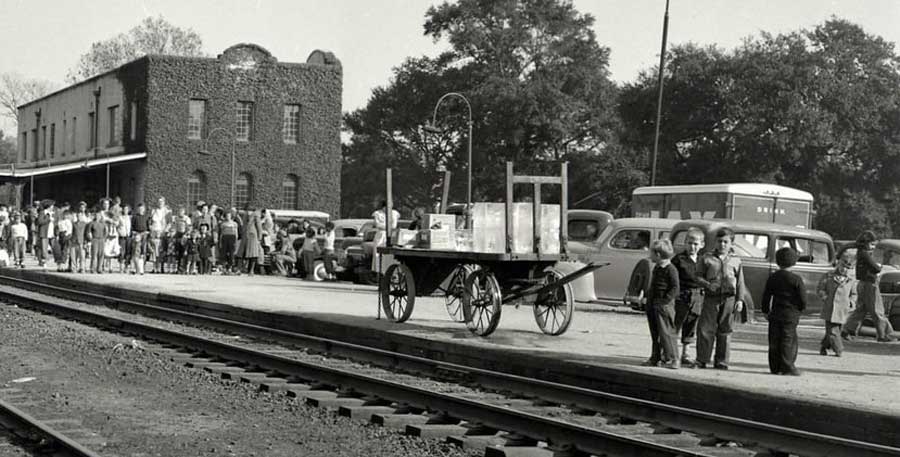What will it take to make a train experience so special, so inviting, that people from New Orleans and Mobile will choose to step onto our Depot platform for an unforgettable Bay Saint Louis vacation? The answer might just be found in our history – and our future decisions.
- by J. Michael Dumoulin
Miss the previous two stories in this series? Never fear!
Single men and women could rent either a hotel “bachelor‘s quarters” or reserve a room in one of BSL’s many boarding houses. Escape from yellow fever, “healthy” water, beaches, and a roaring night life were Bay Saint Louis’s destination draws back then. But passenger rail traffic along the Mississippi Gulf Coast stopped in the early 1970s when the newly formed Amtrak national monopoly scrubbed its financial spreadsheets of the least profitable routes. When Bay Saint Louis didn’t make the cut, the shops along Depot Row struggled to survive. The city and concerned townspeople updated the Depot and its park-like setting, and the Chamber of Commerce and local merchants added more shops along Depot Row, gambling that they could draw visitors up from the beach. The effort was only mildly successful. It wasn’t until 1982, when a handful of governors from states bordering the Gulf created the Southern Rail Commission, that the town began to sense a change of fortune. The appointed commission representatives from each state had one charter: Find a way to resume passenger rail service along the northern Gulf coast. “The commission’s purpose was, and still is, to advocate for passenger traffic,” said Knox Ross, Mississippi chairman of the Southern Rail Commission. Using state funds, Ross explained, the Commission sponsored two test runs of passenger services, the first during the 1984 World’s Fair in New Orleans and a second during the 1996 Olympics. These experiments, along with a much-needed facelift of the historic depot and the extension of east-bound Amtrak service to Jacksonville, Fla., in 1993, rekindled passenger rail traffic along the Gulf Coast. Despite nighttime stops through the region, however, ridership remained low, so low that when Hurricane Katrina provided an excuse to mothball the run, the hue and cry wasn’t loud enough to overcome Amtrak’s fiscal realities. Today, city officials and local merchants are convinced times have changed, and that train service today will be more revenue-friendly than it has been in the past. Depot Row is being revitalized with new restaurants and shops, while the railroad station and its grounds are again getting a much-needed facelift. “The new rail service is going to happen. You can count on it,” Bay Saint Louis councilman-at-large Gary Knoblock told me. “All that’s holding things up are some details in the negotiations between Amtrak and CSX, which owns the tracks,” said Kay Kell, another Mississippi Rail Commissioner. “Otherwise, all the states involved have committed to fund [the effort].” So, what’s changed in the fifty years since the end of a century of successful passenger rail service – 1870 to 1970 – that gives “now” a more optimistic outlook? If the beaches, fishing, and restaurants are different but the same, what special draw – what my old advertising professor used to call “the unique selling proposition, or USP” – might Bay Saint Louis offer a typical visitor from the Midwest or West Coast who has traveled to New Orleans and now wants to spend a week exploring the Gulf Coast? For one thing, the economy is poised to go stratospheric in the next few years as the tethers of a Covid-19 pandemic untie. Two other pluses are a national push for clean public mass transportation and an up-and-coming generation of purchasers demanding value in their vacation experiences. Once again, the business community here is leaning forward, banking on a positive outcome when passenger rail service resumes. Based on all the signs, it seems to be a safe bet. Several projects already have been completed or are on the drawing board, including new or updated restaurants, such as the BBQ Depot in Depot Row and 200 North Beach downtown, both projects of developer Jim MacPhaille. Two new shops have opened in Depot Row this summer – Mon Amie Boutique and Café BoneJour. A new Pilates studio is slated to open soon. MacPhaille has also rescued several historic buildings, such as the 1909 Woodmen of the World Benevolent Society building on 2nd Street, now called The Shops at Century Hall . There are even plans to reopen the A & G movie theater, closed for four decades. But is all this unique enough to entice a rail visitor or New Orleans commuter to spend more time in the Bay than, say, other stops along the new passenger service? What will be BSL’s USPs? You can bet that other cities with stops along the New Orleans-to-Mobile line are asking similar questions. Such “destination draws” – activities that will keep a visitor in the area overnight, or preferably several nights – won’t be season-dependent. And they will need to be unique to BSL, not something like great beaches and seafood that also can be offered by our sister communities. Examples of unique destination draws from around the Southeast might include venues like the John Campbell Folk School in North Carolina, or Arrowmont in Tenn., or the John Holland School in Ga; the Trent Jones Trail of golf courses in Alabama; the group of Fort Worth Stockyards attractions; or the Houston Museum District. One of Bay Saint Louis’s destination draws is its historic districts. The Mississippi Department of Archives and History website still tracks five in our small town. Apparently, part of our brand, our USP, is our last-century setting. After all, we’re “a place apart,” right? Can’t our brand be a “time apart,” too? With our registered historic districts, mammoth live oak trees, and quiet beaches, we have an opportunity to build something quaint, comforting, and quietly vintage, like Havana, Cuba, only uniquely old-fashioned American. Improvements to the Depot and Depot Row are much needed, and they play into this old-timey brand. Once complete, the Depot District will collectively add a strong draw to the Bay. But, again, will it be enough? Have we anticipated all the accommodations a rail tourist will need for a longer stay? For example, visitors coming in by train will need Uber or Lyft services. In addition to a pick-up lane at the depot – so obvious, I’m sure it’s already in the works – I picture a rental car company within walking distance of the depot that offers classic cars for rent by the day or the week. Nothing fancy, maybe a fleet of 1950s Bel Air four seaters, a few vintage 1960s T-bird sports cars, and some pastel VW Beetles thrown in for variety, all with automatic transmissions and air conditioning, of course. One of the historic commercial buildings at the west end of Blaize Avenue or the old gas station and garage on the corner of Washington and 3rd Street would be the perfect spot for something like this. I can see a folk-art academy in the 1920s Spanish Revival-style 2nd Street elementary school, with administrative offices across Ulman Avenue in the Ingram Building. A regionally renowned folk school here would create an all-seasons market for VRBO weekly rentals, and our talented artist community could provide the perfect seed corn of instructors for a destination draw akin to Arrowmont and John C. Campbell. Hancock County’s Infinity Science Center and the Buccaneer water park are great destination draws for visitors with children, but wouldn’t it be fun to resurrect Bay Saint Louis’s old Crystal Ice Bottling Company too? For kids and adults alike, I can see the Boys and Girls Club, the Community Garden, and the Senior Center combining their brands and resources, each contributing to and benefiting from a newly formed community botanical garden. With neighborhood buy-in and the city’s help, the surrounding grounds and vacant lots could become a small, service-oriented, tourist-focused BSL attraction. It could be a new, permanent home for the venerable Bay-Waveland Garden Club! Between Mobile and New Orleans, there’s just not something like this offered around here. And we need a winery. We already have the obligatory great microbrewery, Lazy Magnolia, but my alternate reality would include a vineyard visible to New Orleaners as they pull into the Bay Saint Louis station, maybe on the commercial lot at the corner of Ballentine and Central. There’s already a boutique shop next door, and across Ballentine is a small field that might be perfect for a couple of acres of muscadine vines. Who knows, a winery might “grow” a cottage industry of grape hobbyists, all contributing their backyard yields each fall to augment the small winery’s harvest. Don’t forget, too, that the train line will pass Waveland’s Coleman and Nicholson Avenues. Each December, rail passengers will rubberneck the colossal snowflakes hanging from giant live oak trees as their cars creep over Nicholson into the Bay Saint Louis depot. Maybe a holiday branding opportunity for Waveland?
More importantly, though, owners of vacant lots on Coleman Avenue are just waiting for an excuse to redevelop. With the newly-built lighthouse and beaches at the end of Coleman, visitors are already screaming for the return of restaurants and beach shops. It wouldn’t take much: Coleman Avenue already has a museum, a library, a stellar art venue in Studio Waveland, and a tavern. In my world, Waveland would add golf cart rentals, several competing restaurants, and maybe even a golf course.
The Silver Slipper has already expanded its hotel capacity: all Waveland has to do is add the kinds of destination draws that would convince casino visitors to stay in the area a little longer. Not to be outdone, Clermont Harbor could add more charter fishing boats, maybe host daily or weekly all-day, party-sized trips out to Cat Island or up Saint Louis Bay. I can see adding swamp tours on Bayou Caddy or maybe an annual fishing rodeo. Why not? Of course, every hundred ideas for destination draws comes with at least a hundred reasons why none of these ideas could ever work out. The point is that it only takes one or two to succeed in order to reestablish sustainable passenger rail service again to the Bay. Once we get it back, the community can do everything in its power to keep it running. It’s time to think big, or the history of the past 50 years might just repeat itself. With your help, in the fourth and final part of this series, “Pearl River herself would walk up Nicholson to meet the train,” we’ll recount real-life stories collected from passengers, commuters, and employees who rode and worked the New Orleans-to-Mobile rails. Send us your rail-riding adventures and memories and share with us your first- or second-hand experiences. In Part Four, we’ll also include an update on when you can expect to begin to make new memories as passenger rail service resumes. -- jmd Enjoy the story?
The Shoofly Magazine relies on readers like you to publish stories like this.
Use the button below now to keep 'em coming! Comments are closed.
|
Categories
All
Archives
July 2024
|
Shoofly Magazine Partners
Our Shoofly Partners are local businesses and organizations who share our mission to enrich community life in Bay St. Louis, Waveland, Diamondhead and Pass Christian. These are limited in number to maximize visibility. Email us now to become a Shoofly Partner!











































 RSS Feed
RSS Feed























